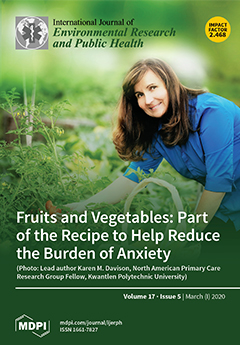High-intensity interval training (HIIT) has similar or better effects than moderate-intensity continuous training (MICT) in increasing peak oxygen consumption (VO
2max), however, it has not been studied when HIIT is applied in a circuit (HIICT). The aim of this study was to
[...] Read more.
High-intensity interval training (HIIT) has similar or better effects than moderate-intensity continuous training (MICT) in increasing peak oxygen consumption (VO
2max), however, it has not been studied when HIIT is applied in a circuit (HIICT). The aim of this study was to compare the effects of a HIICT versus MICT on VO
2max estimated (VO
2max-ES), heart rate (HR) and blood pressure (BP) of middle-aged and older women. A quasi-experimental randomized controlled trial was used. Fifty-four women (67.8 ± 6.2 years) were randomized to either HIICT (
n = 18), MICT (
n = 18) or non-exercise control group (CG;
n = 18) for 18 weeks. Participants in HIICT and MICT trained two days/week (one hour/session). Forty-one participants were assessed (HIICT;
n = 17, MICT;
n = 12, CG;
n = 12). Five adverse events were reported. Cardiorespiratory fitness, HR and BP were measured. The tests were performed before and after the exercise intervention programs. VO
2max-ES showed significant training x group interaction, in which HIICT and MICT were statistically superior to CG. Moreover, HIICT and MICT were statistically better than CG in the diastolic blood pressure after exercise (DBP
ex) interaction. For the systolic blood pressure after exercise (SBP
ex), HIICT was statistically better than CG. In conclusion, both HIICT and MICT generated adaptations in VO
2max-ES and DBP
ex. Furthermore, only HIICT generated positive effects on the SBP
ex. Therefore, both training methods can be considered for use in exercise programs involving middle-aged and older women.
Full article





